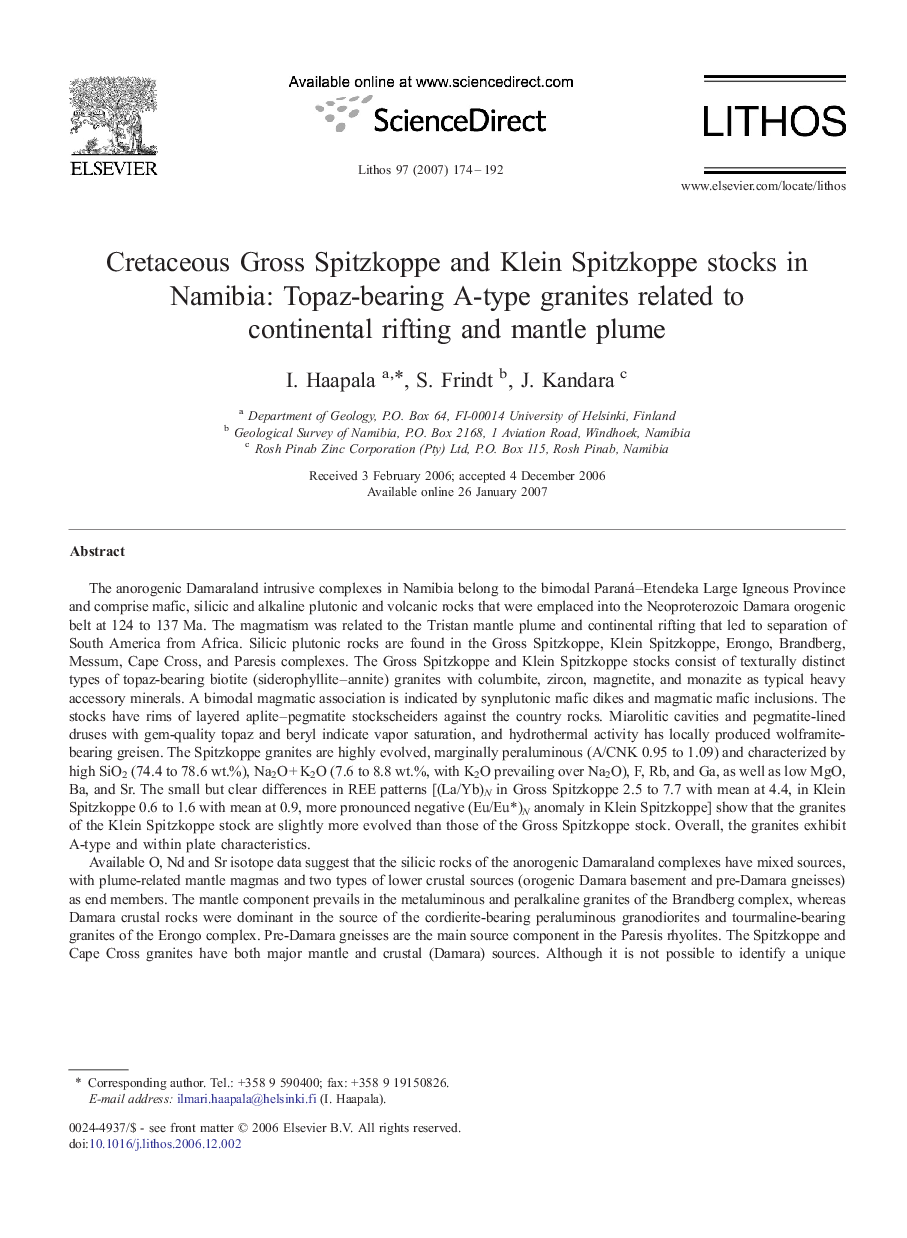| کد مقاله | کد نشریه | سال انتشار | مقاله انگلیسی | نسخه تمام متن |
|---|---|---|---|---|
| 4717716 | 1638766 | 2007 | 19 صفحه PDF | دانلود رایگان |

The anorogenic Damaraland intrusive complexes in Namibia belong to the bimodal Paraná–Etendeka Large Igneous Province and comprise mafic, silicic and alkaline plutonic and volcanic rocks that were emplaced into the Neoproterozoic Damara orogenic belt at 124 to 137 Ma. The magmatism was related to the Tristan mantle plume and continental rifting that led to separation of South America from Africa. Silicic plutonic rocks are found in the Gross Spitzkoppe, Klein Spitzkoppe, Erongo, Brandberg, Messum, Cape Cross, and Paresis complexes. The Gross Spitzkoppe and Klein Spitzkoppe stocks consist of texturally distinct types of topaz-bearing biotite (siderophyllite–annite) granites with columbite, zircon, magnetite, and monazite as typical heavy accessory minerals. A bimodal magmatic association is indicated by synplutonic mafic dikes and magmatic mafic inclusions. The stocks have rims of layered aplite–pegmatite stockscheiders against the country rocks. Miarolitic cavities and pegmatite-lined druses with gem-quality topaz and beryl indicate vapor saturation, and hydrothermal activity has locally produced wolframite-bearing greisen. The Spitzkoppe granites are highly evolved, marginally peraluminous (A/CNK 0.95 to 1.09) and characterized by high SiO2 (74.4 to 78.6 wt.%), Na2O + K2O (7.6 to 8.8 wt.%, with K2O prevailing over Na2O), F, Rb, and Ga, as well as low MgO, Ba, and Sr. The small but clear differences in REE patterns [(La/Yb)N in Gross Spitzkoppe 2.5 to 7.7 with mean at 4.4, in Klein Spitzkoppe 0.6 to 1.6 with mean at 0.9, more pronounced negative (Eu/Eu⁎)N anomaly in Klein Spitzkoppe] show that the granites of the Klein Spitzkoppe stock are slightly more evolved than those of the Gross Spitzkoppe stock. Overall, the granites exhibit A-type and within plate characteristics.Available O, Nd and Sr isotope data suggest that the silicic rocks of the anorogenic Damaraland complexes have mixed sources, with plume-related mantle magmas and two types of lower crustal sources (orogenic Damara basement and pre-Damara gneisses) as end members. The mantle component prevails in the metaluminous and peralkaline granites of the Brandberg complex, whereas Damara crustal rocks were dominant in the source of the cordierite-bearing peraluminous granodiorites and tourmaline-bearing granites of the Erongo complex. Pre-Damara gneisses are the main source component in the Paresis rhyolites. The Spitzkoppe and Cape Cross granites have both major mantle and crustal (Damara) sources. Although it is not possible to identify a unique petrogenetic process by which the Damaraland complexes formed, it is clear that the magmas formed in an extensional environment and that both mantle and crustal sources were involved in production of these magmas.
Journal: Lithos - Volume 97, Issues 1–2, August 2007, Pages 174–192